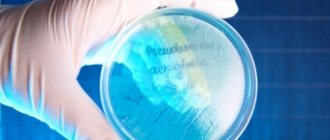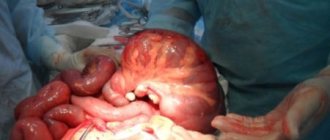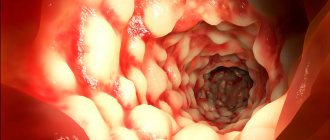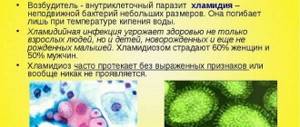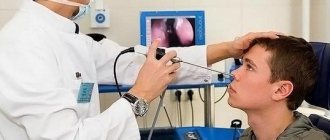Functions of E. coli in the human body
E. coli bacteria are essential for human life.
This group contains various microorganisms called coliform bacteria. They make up only one percent of the intestinal microflora and solve a number of important problems:
- perform a protective function, preventing the development of diseases;
- their presence contributes to the proliferation of bifidobacteria and lactobacilli;
- participate in the metabolism of fats and cholesterol;
- participate in the production of vitamins B (the entire group) and K;
- improve the absorption of compounds with iron and calcium;
- strengthen the name system of children (up to 7 years).
The impact of beneficial E. coli is invaluable throughout life, but pathogenic strains of these bacteria provoke diseases, cause poisoning, destroy the beneficial intestinal environment, and have a destructive effect on the immunity of adults and children. In the latter case, this is doubly dangerous, since the fragile child’s body becomes defenseless to the aggressive external environment.
Attention! E. coli is very dangerous during pregnancy: the infection can penetrate the fetus, develop pathologies and lead to miscarriage. E. coli are quite stable, they are able to survive for some time, even if they leave the human body. It helps in medical research and treatment, collecting information through stool, urine analysis, etc.
Prevention of E. coli
All preventive measures for Escherichia coli boil down to the following recommendations:
- observe the rules of personal hygiene;
- wash vegetables and fruits thoroughly;
- follow the rules of heat treatment of meat;
- do not drink raw milk;
- purchase meat and dairy products only from trusted sellers with a quality certificate for the product;
- strengthen immunity;
- regularly carry out wet cleaning in the house.
Intestinal infection is common among adults and children. Not only is it accompanied by severe symptoms, but it can also lead to severe dehydration, disruption of important body functions, and death of the patient.
It is important to follow preventive measures and treat E. coli at the first manifestations
Prevention of diseases caused by E. coli consists primarily of observing generally known hygiene rules. Equally important is the consumption of thoroughly washed vegetables and fruits, safe water and dishes prepared in accordance with technological standards.
In conclusion, it must be emphasized once again that both adults and children are at risk of infection with pathogenic Escherichia coli. In both cases, infection can provoke a very unpleasant pathological condition. But it is curable. The main thing is not to engage in amateur activities and not to take antibacterial drugs without a doctor’s prescription.
Maintaining personal hygiene to prevent E. coli
Maintain personal hygiene: thoroughly wash your hands and face after going outside and in crowded places, a competent approach to intimate hygiene. Monitoring the purity of consumed raw products and bringing milk and meat to the desired state. Drink only high quality water. Use of disposable clothing in hospital settings. Monitoring the hygiene and health of pets. Regular cleaning of residential premises using reliable but not aggressive detergents
Be careful when eating in public catering establishments and while on vacation in hot countries
Bacterial colonies and their appearance
Modern research methods make it possible not only to see bacteria and the internal structure of a bacterial cell under a microscope, but also to take photos and videos of these organisms and what they look like. Based on these data, bacteria were divided into groups characterized by different geometric shapes.
- Round bacteria, or cocci. They appear as spheres or ovals, often have a rigid cell wall and are Gram stained. Looking at photographs taken under a microscope, you can find that they can be single, double (diplococci), in the form of clusters (staphylococci), packets of 8 or more cells, or collected in chains of varying lengths (streptococci). Among them are many harmless saprophytes that live on the skin and in the intestines, there are inhabitants of hot springs and glaciers, as well as symbionts that are part of lichens. Such cocci are often colored, which is clearly visible when their colonies are grown on a nutrient medium. There are also bacteria in this group that can cause suppuration, wound infections, pneumonia and other dangerous diseases. Interestingly, colonies of saprophytic cocci are usually brightly colored, while pathogenic cocci form colorless colonies.
- Rod-shaped bacteria, or bacilli. They look like straight or curved sticks of varying thickness and sizes. Depending on the place of spore formation, a distinction is made between clostridia (with a thickening at one end in the form of drumsticks) and plectria, whose spores are spindle-shaped. Just like cocci, bacilli can form groups of two cells (diplobacillus); there are also bacteria that form long chains (streptobacilli). Bacilli can have a wide variety of types of nutrition - there are saprophytic forms that live on the skin, intestines, and teeth. Among them, the most famous are E. coli, lactobacilli, pathogens of anthrax, plague, tetanus, gas gangrene, and salmonella. There are also free-living bacilli - nitrogen fixers; there are aerobic and anaerobic forms.
- Curved bacteria - spirilla, vibrio and spirochetes. Often detected in urine in the presence of genitourinary tract infections. The latter are distinguished by mobility, and the former by a variety of bends. In the photo, vibrios differ in that their bend is no more than a quarter of a turn, spirilla have 4-6 turns, and even more curved forms with 7-15 turns are called spirochetes. The video suggests that spirochetes appear to be more mobile compared to other curved bacteria.
- Prostecobacteria may appear as triangles. In the photo, these unusual organisms demonstrate the presence of characteristic outgrowths with sharp ends.
- Mycobacteria are bacilli with lateral projections.
- Corynebacteria. Rods with thickenings at the ends and grains inside the cell.
- Actinomycetes. Multicellular bacteria consisting of branching chains that look like fungal mycelium. The threads are capable of fragmenting into individual cells (cocci or rods) or their aggregates.
If you look at a photo of what human skin looks like under high magnification, or inoculate a smear from the skin on a nutrient medium, you will find that many pathogenic bacteria are constantly found in small quantities on human skin.
In fact, the number of bacterial cells in the human body is even slightly greater than those that make up organs and tissues. Many of them live in the intestines and stomach, inhabit the genitals, and are found in urine, sputum and other secretions. When sown on nutrient media, they form colonies that look different depending on the species. Similar colonies can be observed in nature - for example, in blue-green algae, actinomycetes and archaea.
Photos of colonies of the same type of bacteria may look different depending on the growing conditions, the presence of vitamins and minerals in the nutrient medium, and its density. Colonies can look large (diameter more than 4-6 mm), medium (2-4 mm in diameter) and small, have a round, oval, branching (rhizoid), rosette shape, differ in transparency or color, relief, consistency.
For example, spirilla Helicobacter pylori, when determined in the intestines or urine of women by inoculating feces on solid media, forms transparent, shiny colonies of small size, and in liquid media they form thin grayish-blue films and look like a slight turbidity of the liquid. Sulfur-recycling ones form colonies in the form of colored mucus on the stones of reservoirs and springs, and nitrogen-fixing actinomycetes look like small thread-like roots, almost invisible in the root system of the plant.
When determining bacteria in human urine, the most common bacteria are Escherichia coli, lactobacilli, Proteus, Klebsiella, and Enterococcus. The appearance of their colonies allows you to visually assess the presence of bacteria in the urine and determine their sensitivity to antibiotics. For differential diagnosis of bacteria in urine, specific antibiotics or nutrients can be added to the media to allow the isolation of pure cultures of bacteria of one species.
I work as a veterinary doctor. I am interested in ballroom dancing, sports and yoga. I prioritize personal development and mastering spiritual practices. Favorite topics: veterinary medicine, biology, construction, repairs, travel. Taboos: law, politics, IT technologies and computer games.
E. coli is normal
Under normal conditions, E. coli colonizes the human intestine (safe strains), the average amount varies from 106 to 108 CFU/g of distal intestinal contents (CFU - colony-forming unit). The content of E.coli in other intestinal microflora is no more than 1%. Under normal conditions, E. coli take part in the normal functioning of the intestines, synthesizing vitamins K, B1, B2, B3, B5, B6, B9, B12.
The non-pathogenic strain Nissle 1917 (Mutaflor) is used for medicinal purposes in children as a probiotic for intestinal dysbiosis. In the intestines, the so-called lactose-positive E. coli are more useful; the content of lactose-negative ones should not exceed 105 CFU/g, and hemolytic E. coli should be completely absent.
The qualitative and quantitative composition of E.coli in the large intestine in healthy people of different ages, both in children under one year old and over 60 years of age, does not differ. For typical E.coli this is 107-108 CFU/g of feces, E.coli lactose-negative {amp}lt; 105, hemolytic E. coli are normally absent. The composition of the rest of the intestinal flora differs by age in other respects.
Deviations in the content of non-pathogenic strains of Escherichia coli in the intestine are called dysbiosis and have several degrees.
Degrees of microbiological disorders of E. coli in intestinal dysbiosis
- 1st degree of microbiological disorders: typical Escherichia up to 106-105 CFU/g, it is possible to increase the content of typical Escherichia up to 109-1010 CFU/g.
- 2nd degree of microbiological disorders: increase in the content of hemolytic Escherichia to a concentration of 105-107 CFU/g.
- 3rd degree of microbiological disorders: detection of E. coli in association with other opportunistic microorganisms at a concentration of 106-107 CFU/g and higher.
Model organism
E. coli
often used as a model organism in microbiological studies.
Cultivated strains, such as E. coli
K12, are well adapted to grow in vitro and, unlike wild-type strains, are unable to colonize the intestine. Many laboratory strains have lost the ability to form biological films[24][25]. The described features protect wild-type strains from antibodies and chemical agents, but require large amounts of substance and energy.
In 1946, Joshua Lederberg and Edward Tatham described the phenomenon of bacterial conjugation using Escherichia coli as a model organism[26]. E. coli
remains one of the most popular bacteria in the study of conjugation at the present time.
E. coli
was an important component of early bacteriophage genetics experiments[27], with early researchers such as Seymour Benzer using
E. coli
and phage T4 to study gene structure[28]. Before Benzer's research, it was not known whether the gene had a linear or branched structure.
Escherichia coli E. coli
was one of the first organisms whose genome was completely sequenced.
The nucleotide sequence in the genome of E. coli
was published in the journal
Science
in 1997[29].
Long-term experiment on the evolution of E. coli
was started by Richard Lenski in 1988 and allowed direct observation of evolutionary changes in laboratory conditions[30].
In this experiment, one population of E. coli
was able to aerobically metabolize citrate.
This ability is
normally extremely rare
E. coli The inability to grow under aerobic conditions is used to distinguish E. coli
from other related bacteria, such as
Salmonella
. During this experiment, in laboratory conditions, it was possible to observe the process of speciation.
Acid-fast bacteria and gastritis
For a long time it was believed that increased acidity in the stomach protects it from the penetration of bacteria. This misconception was refuted by the discovery of the causative agent of gastritis and stomach ulcers - the Helicobacter pylori bacterium. The cells of these bacteria look like gram-negative spirilla in shape.
Old Helicobacter cultures are full of cells that look like cocci - these cells help the culture survive unfavorable conditions. Cocci bacteria of the genus Helicobacter are also able to settle on the inner walls of the digestive tract and are found in natural sources, but they cannot grow in cultures.
Pathogenic Escherichia coli
There are more than 100 strains of pathogenic E. coli, which are grouped into 4 classes:
- enteropathogenic E. Coli (ETEC);
- enterotoxigenic E. coli;
- enteroinvasive E. coli (EIEC);
- enterohemorrhagic E. coli (EHEC).
Morphologically they are no different. A feature of pathogenic strains is the ability, when they enter the human body, to produce enterotoxins (thermostable or resistant to high temperatures and thermolabile or rapidly degrading), due to which diarrhea occurs. For example, E. coli O157:H7, which produces similar toxins.
In addition, each group has its own characteristics of the symptoms of the disease.
What is Escherichia coli?
Escherichia coli is a bacteria belonging to the genus Escherichia and the family Enterobacteriaceae. These microorganisms are highly resistant; they can live for months in water, soil, and feces.
A group of diseases associated with Escherichia coli and caused by pathogenic strains of the bacterium are called Escherichiosis. They act as causes of diseases of the intestines, kidneys and other organs. This creates a number of problems in the field of digestion and the genitourinary system.
Bacteria multiply quickly and well in food, especially in milk, and therefore eating food contaminated and contaminated with E. coli causes infection with the subsequent development of an infectious-inflammatory disease.
How can you get infected?
E. coli is transmitted mainly through the oral-fecal route or, less commonly, through household contact.
Through the oral-fecal route of transmission, E. coli gets into the water or soil through feces, as well as onto agricultural plants. Further infection can occur in various ways, for example, when swallowing dirty water, bacteria enter the body and lead to the development of intestinal infections.
Contact and household spread of E. coli is less common and plays the greatest role in the development of outbreaks of escherichiosis in communities, for example, in hospitals, maternity hospitals, kindergartens, schools, families, etc. Through contact and household contact, E. coli can be transmitted from mother to newborn baby when the latter passes through the birth canal contaminated with bacteria.
Causes of pathology
The main reason for the appearance of E. coli is a violation of the intestinal microflora. This is why the pathogenic serotype of Escherichia coli multiplies. The cause of its occurrence is quite often a variety of diseases of the digestive tract. Quite often, the pathological process is diagnosed against the background of pancreatitis, which affects the pancreas.
These traditional medicines suppress microorganisms, eliminating the possibility of pathogenic microflora appearing. Taking antibacterial drugs quite often leads to pathology. A person can become infected with pathogenic strains through the fecal-oral route.
Pathology develops when a person fails to comply with hygiene rules during food preparation. If a patient eats unwashed vegetables and fruits, this often leads to the development of E. coli. When watering plants with dirty wastewater after eating them, E. coli may appear.
It is also caused by eating raw milk or undercooked meat. In most cases, E. coli appears due to a person’s unhealthy lifestyle. That is why patients are advised to be attentive to their health.
Treatment rules
In addition to taking antibiotics, the patient must follow certain treatment rules.
If a patient experiences diarrhea or vomiting, he must drink rehydration solutions.
With their help, lost fluid and salt are replenished.
For each bowel movement and vomiting, you should drink 300 to 600 milliliters of rehydration solution.
For its preparation, pharmaceutical powder in the form of Trisol, Regidron, Glucosolan can be used.
You can also use baking soda, salt and sugar to prepare the solution. When purchasing traditional medicines, you simply need to dilute them in water according to the manufacturer's instructions.
To prepare a homemade rehydration solution, you need to take a liter of clean water and add a tablespoon of sugar to it. You also need to add baking soda and salt 0.5 tablespoons each. If there is no rehydration solution in the house, the patient is recommended to drink any drinks.
Compotes, fruit drinks, and teas with sugar are quite effective. To ensure the highest quality treatment of infectious diseases that arise when E. coli appears, it is recommended to take enterosorbents:
To ensure comprehensive treatment of the disease, it is recommended to use probiotics - Baaktisubtil, Enterol, Bifidumbacterin. If a patient experiences an increase in body temperature of more than 38 degrees, then he is recommended to use antipyretic pharmaceutical medications, the basis of which is ibuprofen, nimesulide, paracetamol.
With the help of traditional medicines, you can eliminate not only the symptoms of the disease, but also destroy E. coli in the human body.
What diseases does the infection cause?
Since bacilli most often end up in the gastrointestinal tract, they therefore cause gastrointestinal diseases, as well as intestinal infections (escherichiosis), which are accompanied by symptoms of intoxication.
The following diseases may occur:
- enteritis and hemorrhagic colitis;
- inflammation of the vagina, uterus and appendages;
- prostatitis, orchitis, epididymitis in men;
- colpitis, vulvovaginitis;
- inflammation of the kidneys and bladder;
- urethritis;
- otitis;
- neuritis.
The specific symptoms of E. coli depend on the strain.
E. coli: symptoms and signs
In the practice of infectious disease doctors, both etiopathogenetic and clinical classifications of Escherichia coli are used. The division of E. coli according to the clinical principle consists of including the main clinical symptom complex in the diagnosis, for example, “gastroenteric E. coli”. In addition, it is imperative to indicate the severity of E. coli, which can vary widely.
Enterotoxic Escherichia coli is a provocateur of the development of pronounced clinical symptoms in children. This type of pathogen is characterized by a short incubation period, at the end of which a pronounced intoxication and dyspeptic syndrome develops, as well as intestinal dysfunction. The danger of E. coli in this situation lies in the tendency to rapid development of dehydration of the child’s body, as well as generalized sepsis, in which the prognosis for recovery is minimal.
With the cholera-like variant of the course of E. coli, a short period of incubation of the pathogen and moderate signs of intoxication are noted. Symptoms more characteristic of this variant of the clinical course are severe pain in the abdominal cavity, disruption of intestinal activity and increasing dehydration syndrome.
If hemolytic type Escherichia coli enters the human body, the clinical picture of catarrhal-hemorrhagic colitis develops. The duration of active clinical symptoms in this situation is about one week, however, with a complicated course, the development of hemolytic-uremic syndrome may be observed.
Escherichia coli during pregnancy
In pregnant women, E. coli is often detected in vaginal smears and urine. Moreover, many women say that before pregnancy the bacterium was never found in tests. This does not mean that the woman became infected during pregnancy. On the contrary, the detection of Escherichia coli indicates that a woman has long been a carrier of E. coli, but during pregnancy her immune system can no longer suppress the activity of this microbe, as a result of which it has multiplied so much that it could be detected in tests.
The appearance of bacteria does not mean that a woman is necessarily sick, but indicates that her genital tract or urinary system is contaminated with E. coli, which can provoke an inflammatory process at any time. Therefore, even in the absence of symptoms of the disease, gynecologists treating pregnancy prescribe antibiotics to destroy the bacteria.
After all, if E. coli remains in the urine, sooner or later this will lead to pyelonephritis or cystitis in a pregnant woman. If E. coli remains in the vagina, this can lead to colpitis, which, as is known, can provoke premature rupture of amniotic fluid.
In addition, the presence of E. coli in the vagina before birth poses a danger to the fetus, since the baby can become infected with the microbe while passing through the mother's birth canal. And such an infection of the baby can lead to the development of serious diseases, such as sepsis, meningitis, otitis media or intestinal infection, which are deadly for the newborn.
Thus, it is obvious that the detection of E. coli in a vaginal smear or in the urine of a pregnant woman requires mandatory treatment, even if there are no symptoms of an inflammatory process in the kidneys, bladder, urethra or vagina.
Symptoms and types of infection caused by Escherichia coli (coli infections)
The incubation period (from the moment of infection to the onset of symptoms) for coli infection lasts 1-6 days; usually 3 days.
There are intestinal coli infections, paraintestinal coli infections and septic coli infections.
Intestinal coli infection
Intestinal coli infection occurs primarily in the small or large intestine. The incubation period in both cases is up to 3 days, but when the colon is affected, it is slightly shorter.
Here are the symptoms of predominant damage to the small intestine:
- acute onset;
- weakness, dizziness, in half of the cases an increase in body temperature to 37.5-38.0 degrees;
- in ⅓ of cases nausea and vomiting;
- cramping pain throughout the abdomen; bloating and rumbling stomach;
- frequent loose stools, from which fecal impurities disappear within a few hours; there is no foul odor.
Now the symptoms of predominant damage to the colon:
- 60% of patients have an acute onset: chills, severe weakness, headache;
- in ¾ of patients the body temperature increased to 38 degrees; for the rest - up to 39-40 degrees;
- watery diarrhea lasting up to 8 hours;
- symptoms of colitis, which are replaced by watery diarrhea: pain in the lower abdomen with a false urge to defecate; pasty stool with mucus and streaks of blood up to 10 times a day.
Paraintestinal coli infection
Strains of Escherichia coli that are non-pathogenic for the intestines, when they enter other organs and cavities, can cause diseases united under the concept of “Paraintestinal coli infection”. Here are the most common of them:
- peritonitis, if E. coli enters the abdominal cavity through a damaged wall of the stomach and intestines, for example, with peptic ulcer of the stomach and duodenum, perforated appendicitis, colitis, Crohn's disease, etc.;
- pyelonephritis, urethritis - when the infection penetrates the urinary tract;
- inflammation of the vaginal mucosa (colpitis) - when E. coli enters the vagina;
- pneumonia, if coli infection enters the lungs;
- meningitis - as a result of infection entering the meninges.
Septic coli infection
Most often occurs in newborns and premature babies. Intestinal manifestations - diarrhea and spastic pain, as a rule, are not pronounced. Symptoms of severe intoxication, high fever, vomiting, and anorexia predominate. Purulent foci form in the internal organs.
Escherichia coli in infants
When testing for dysbacteriosis or coprogram (scatology), two types of E. coli are often found in the stool of infants - hemolytic and lactose-negative. In principle, hemolytic Escherichia coli should not be present in the feces of either an infant or an adult, since it is a purely pathogenic microbe and causes intestinal infections that occur as hemorrhagic colitis.
However, if hemolytic E. coli is detected in an infant, you should not rush to start treatment with antibiotics. To understand whether your baby needs to be treated, you should objectively assess his condition. So, if a child gains weight normally, develops, eats well and does not suffer from watery yellow stool that literally streams out of the child’s anus, then there is no need to treat the baby, since therapy is necessary only if there are symptoms, and not numbers in the tests.
Lactose-negative Escherichia coli may well be present in the feces of a baby, since it is a component of normal microflora, and normally can account for up to 5% of the total amount of all Escherichia coli present in the intestines. Therefore, the detection of lactose-negative Escherichia coli in the stool of a baby is not dangerous, even if its quantity exceeds the norms indicated by the laboratory, provided that the child is gaining weight and developing normally.
Diagnostics
When an intestinal infection occurs, the method of diagnosing the disease is of utmost importance, which will help determine the specific type of bacteria, find the correct method of treatment and take timely action.
- A method of bacteriological research, which is carried out using the inoculation of various materials:
- if the intestines are damaged, stool or vomit is analyzed;
- in case of damage to the urinary tract, urine is analyzed;
- in case of infection of the genital organs, a smear or scraping from the mucous membrane is taken.
Materials are placed in special environments in which microorganisms multiply; they are then tested for sensitivity to antibiotics. This helps the doctor prescribe the most effective medications for treatment.
- The research method using special medications involves the use of ultrasound, urography, etc.
- The method of general clinical research is widespread. It does not detect pathogenic bacteria, but can confirm the presence of inflammation in stool, urine, pus or blood. Used as an additional diagnostic method.
Microorganisms appear in the genitourinary system during anal sex and failure to comply with basic hygiene rules. Bacteria enter the urinary tract from the intestines, become attached to them and are not completely washed out when urinating.
E. coli bacteria, when found in urine, are not a sign of infection. This may be a manifestation of pathological changes in the urinary system.
E. coli in a smear in women is a consequence of:
- wearing tight underwear;
- unprotected anal sex;
- failure to comply with hygiene rules.
During pregnancy, the presence of pathogenic bacteria is risky for the baby. E. coli in the vagina can pass to the baby during childbirth and cause meningitis.
Escherichia coli in urine and smears
If personal hygiene rules are not followed, as well as during sexual intercourse, E. coli can penetrate the vagina. In the future, this microorganism provokes the development of vaginitis and colpitis, and with a decrease in immunity, the bacterium is able to penetrate the urinary organs and cause inflammation (cystitis, pyelonephritis).
To diagnose diseases of the genitourinary system, it is necessary to conduct a urine test. However, the presence of E. coli in the urine does not always indicate the presence of a disease. Bacteria found in small quantities may mean that the woman did not perform proper hygiene procedures before taking the test.
In men, E. coli is often the cause of prostatitis, orchitis or epididymitis.
Escherichia coli as a causative agent of diseases of the genitourinary system
Normally, E. coli should not be detected in the urine, but if it was found there during tests, the doctor should urgently treat it. Typically, this microorganism is discovered by gynecologists when examining pregnant women, and for many, the presence of this microorganism in the vaginal microflora comes as a surprise. Detected E. coli in a smear indicates the beginning of the development of an inflammatory process in one or more organs of the genitourinary system (there is a possibility that the bacterium is sexually transmitted from one partner to another).
It must be said that E. coli in the vagina should be a reason to leave the laboratory and immediately go to the doctor’s office. The fact is that it significantly weakens local immunity and makes the sick person’s body practically defenseless against other dangerous bacteria, for example, proteus or staphylococcus, which can ultimately cause the development of gonorrhea or chlamydia, therefore, this condition should only be treated by a specialist.
Gonorrhea in women
Hemolyzing E. coli is the cause of the development of 80% of diseases of the genitourinary system, which include:
- acute and chronic prostatitis in men (Escherichia coli is detected in a smear when diagnosing prostatitis in almost 65% of cases);
- inflammation of the ovaries and appendages in women;
- cystitis;
- vaginitis (if E. coli is detected immediately in a smear for vaginitis, then treatment of this disease occurs as quickly as possible, and the lack of adequate therapy can cause the development of serious health problems);
- pyelonephritis (very often hemolyzing E. coli is detected when diagnosing pyelonephritis in pregnant women);
- colpitis and so on.
In fact, in gynecology, hemolyzing Escherichia coli occupies a special place, because when it enters the vagina, it provokes the development of a number of diseases that subsequently lead to infertility and are difficult to treat. For this reason, doctors advise preventing and diagnosing this pathogen (E. coli is determined in a smear) at least once a year.
How to treat E. coli?
Treatment of intestinal infections caused by coli is usually complex and includes the following points:
- Antibiotics. Antibacterial therapy forms the basis of treatment for E. coli. A particular drug is prescribed after determining the sensitivity of microorganisms to it. The most commonly recommended antibiotics are the cephalosporin group: Cephelim, Cephalexin, Levofloxacin. The drugs are taken in courses of 5-10 days. The course cannot be interrupted or the dosage exceeded without the doctor's permission.
- Bacteriophages. These are drugs that kill bacteria more gently and safely than antibiotics, but they are not always effective. Essentially, bacteriophages are viruses that live and reproduce only in the presence of certain bacteria. These viruses exist at the expense of bacteria, destroying them. Bacteriophages include Sextaphage, Intesti-bacteriophage, etc.
- Painkillers. If the abdominal pain is severe, painkillers such as No-shpa, Bral, Spasmalin, Nurofen are prescribed. However, they should not be taken for a long time.
- Probiotics. Probiotics (Linex, Bifidumbacterin, etc.) help restore the normal balance of pathogenic and beneficial microorganisms in the intestines.
Treatment and dosage of drugs must be prescribed by a doctor. Self-medication can be dangerous, especially during pregnancy or early childhood.
How to treat?
E. coli should be treated by a doctor who first does a bacterial culture and accurately determines the strain of the pathogen. The intensity and duration of drug therapy depends on the type of bacterium, its location and the individual characteristics of the sick person’s body. Diet and the intake of probiotics – drugs that normalize intestinal microflora – play an important role in the treatment process. After completing the course of drug therapy, all tests are taken again.
What to do?
If you think you have E. coli
and the symptoms characteristic of this disease, then doctors can help you: an infectious disease specialist, a gynecologist, a gastroenterologist.
Source
Did you like the article? Share with friends on social networks:
Consequences
Escherichia coli can cause disease in organs other than the intestines. In the urinary tract, this bacterium can also cause inflammation. In girls and women, this risk is higher than in men, because... they have a short path from the intestine to the urethra.
In addition, the bacterium is often the culprit of respiratory infections, the cause of neonatal meningitis (inflammation of the brain), etc. These conditions apply mainly to weak and long-term bedridden people.
Treatment for intestinal infections often consists only of fluid replenishment, diet, and supplementation of appropriate bacteria that prevent E. coli from multiplying. Antibiotics have been found to increase the secretion of toxin from bacteria, so it can sometimes be difficult to decide on a specific treatment option. In case of inflammation of other organs and tissues, treatment always involves the use of antibiotic drugs.
Symptoms of E. coli
Symptoms of E. coli infection manifest themselves differently, so each class of pathogenic bacteria must be considered separately. The health status of an infected person will depend on which group the E. coli bacteria belong to and at what speed they multiply; the symptoms of the diseases are described below.
General signs of the development of pathogenic E. coli in the body include symptoms such as:
- Disturbance of the digestive process;
- Pain in the abdominal area;
- Vomiting and nausea;
- Manifestations of flatulence;
- Unpleasant odor from the mouth;
- Weakness;
- Drowsiness;
- Loss of appetite;
- Increased body temperature;
- Fall in blood pressure.
Depending on the type of bacteria, a person notices the presence of certain signs.
Symptoms depending on the type of bacteria
Escherichiosis, caused by enteroinvasive bacilli, causes damage to the large intestine. The disease develops with the appearance of general intoxication symptoms:
- weaknesses,
- headache,
- chills,
- temperature rise.
A few hours later, cramping pain occurs in the lower abdomen.
- Diarrhea occurs, the stool is initially watery and profuse. But as the colon becomes damaged, colitis develops.
- Symptoms of this condition are frequent loose or pasty stools mixed with mucus and streaked with blood.
This variant of escherichiosis is characterized by a benign course. Temperature and stool return to normal after one to three days.
Intestinal infections caused by enteropathogenic Escherichia coli in adults and children over 3 years of age occur as salmonellosis. That is, the disease begins acutely:
- nausea appears
- vomit,
- stomach ache,
- body temperature rises moderately or slightly.
The stool becomes thin, watery and profuse, and the patient goes to the toilet 2-6 times a day. When defecating, stool literally splashes out. The infection lasts on average for 3 to 6 days, after which recovery occurs.
Enterotoxigenic E. coli are dangerous because they can attach specifically to the intestinal mucosa, which significantly disrupts its functioning. The infection is transmitted through unwashed hands or fruit, so the symptoms of intestinal bacteria in the human body are sometimes called “traveler's diarrhea,” which is accompanied by:
- watery diarrhea without blood,
- nausea,
- paroxysmal abdominal pain.
Manifestations of enterohemorrhagic infection:
- Necrosis;
- Presence of blood clots (in stool);
- Peritonitis;
- Diarrhea (watery stools).
Symptoms of infection in a child are more severe, especially when affecting newborns or children with low body weight.
Escherichia coli can cause disease in organs other than the intestines. In the urinary tract, this bacterium can also cause inflammation. In girls and women, this risk is higher than in men, because... they have a short path from the intestine to the urethra.

